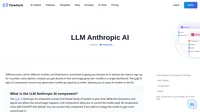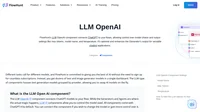August 23, 2024
In recent developments, MIT researchers have made significant strides in understanding and utilizing large language models (LLMs) for various applications, revealing both their potential and limitations. These advances are pivotal as LLMs become increasingly integrated into diverse sectors, from healthcare to engineering.
Human Beliefs and LLM Performance
A recent study by MIT highlights the crucial role of human beliefs in the performance of LLMs. The research, led by Ashesh Rambachan and his team, discovered that the effectiveness of an LLM is heavily influenced by how well it aligns with the user’s expectations. When there is a misalignment, even highly capable models can fail unexpectedly in real-world scenarios. This misalignment often leads to either overconfidence or underconfidence in the model’s capabilities, which can result in suboptimal deployment decisions.
The study introduced a “human generalization function” to evaluate this alignment. This function models how people form and update beliefs about an LLM’s capabilities based on their interactions with it. The researchers found that while humans are good at generalizing a person’s capabilities from limited interactions, they struggle to do the same with LLMs. This insight underscores the need to incorporate human generalization into the development and training of LLMs to improve their real-world performance.
LLMs for Anomaly Detection in Complex Systems
Another breakthrough from MIT researchers involves the application of LLMs to detect anomalies in complex systems. The team developed a framework called SigLLM, which converts time-series data into text-based inputs that LLMs can process. This method allows LLMs to be deployed as off-the-shelf solutions for anomaly detection without the need for extensive retraining.
Although LLMs did not outperform state-of-the-art deep learning models in this task, they showed promise in certain areas, indicating potential for future improvements. The researchers aim to enhance the performance of LLMs in anomaly detection, making them viable tools for predicting and mitigating issues in equipment such as wind turbines and satellites.
Broader Implications and Future Research
These findings have broad implications for the deployment and development of LLMs. The insights from the human generalization study suggest that developers need to consider how users form beliefs about model capabilities, which could lead to better-aligned and more reliable LLMs. The anomaly detection research opens new avenues for using LLMs in complex, high-stakes environments, potentially reducing the costs and expertise required for maintaining deep learning models.
Moving forward, the researchers plan to conduct further studies on how human interactions with LLMs evolve over time and how these interactions can be leveraged to improve model performance. Additionally, they aim to explore the application of LLMs to other complex tasks, potentially broadening their utility across various domains.
These advancements signal a significant step toward more effective and user-aligned LLMs, paving the way for their expanded use in solving complex problems and enhancing decision-making processes in numerous fields.
Large Language Model Meta AI (LLaMA)
Discover Meta's LLaMA: a powerful 65B-parameter AI for translation, summarization, and chatbots, setting new benchmarks in language processing.




